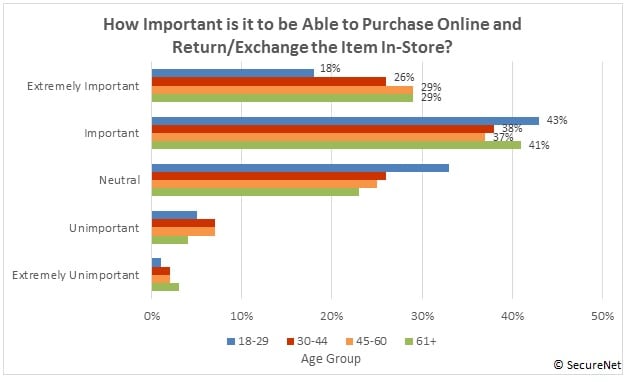The holiday shopping season has settled, but the challenge is far from over for retailers as 2014 comes to a close and new trends in the way customers shop continue to take shape in 2015. Even while mobile shopping continues to grain traction in the United States, merchants are facing increased pressures to create omnichannel environments for their increasingly connected consumers, who are leveraging multiple touchpoints to research, compare and buy their favorite products and services.
The Rise of Mobile Showrooming
Showrooming is the act of visiting a store to examine an item before purchasing it online, often for a lower price, and it is here to stay in 2015. According to a new SecureNet study of 750 American consumers called The Way We Pay, more than half of consumers (55 percent) have used a mobile device to research a product while in store. Among the 18- to 29-year-old demographic, that number jumps to 68 percent. For the 30-44 demographic, that number jumps even higher to 72 percent.
 These finding demonstrate that showrooming is indeed alive and well – especially among younger shoppers. Customers expect new channels and technologies to fit seamlessly into their buying habits and create a complete ecosystem through which they move for just one purchase. Consumers want the ability walk into their store, “window shop” a product and scan the merchandise bar codes for more information, read reviews, explore variations and price points, and complete or return their purchase in-store, online and via their own device all within a single experience.
These finding demonstrate that showrooming is indeed alive and well – especially among younger shoppers. Customers expect new channels and technologies to fit seamlessly into their buying habits and create a complete ecosystem through which they move for just one purchase. Consumers want the ability walk into their store, “window shop” a product and scan the merchandise bar codes for more information, read reviews, explore variations and price points, and complete or return their purchase in-store, online and via their own device all within a single experience.
Webrooming Takes Center Stage
Webrooming, on the other hand, is the act of researching products online or via mobile device for the best deal before buying in-store, and this practice will also continue in the year ahead. Product comparisons and price matching are on the rise and this suggests customers expect retailers to honor sales, purchases and store policies outside of the physical store. In fact, the majority (more than 50 percent) of all age groups surveyed by SecureNet rated the ability to make a purchase online and return or exchange it in-store as “important” or “extremely important.”
 Consumer demands for cross-channel sales and returns are fuel to the fire for emerging trends like webrooming, which also starts in one medium and ends in another. These numbers, and the findings on showrooming, underline the importance of retailers providing a seamless shopping experience across all channels. In the “Age of the Customer,” – a term first coined by Forrester – merchants who can’t keep up will risk losing sales. Integrated, mobile-friendly inventory management solutions will be key in giving merchants the ability to manage and transfer product stock across channels, store consumer payment information across channels and reconcile all of that information and activity in real time.
Consumer demands for cross-channel sales and returns are fuel to the fire for emerging trends like webrooming, which also starts in one medium and ends in another. These numbers, and the findings on showrooming, underline the importance of retailers providing a seamless shopping experience across all channels. In the “Age of the Customer,” – a term first coined by Forrester – merchants who can’t keep up will risk losing sales. Integrated, mobile-friendly inventory management solutions will be key in giving merchants the ability to manage and transfer product stock across channels, store consumer payment information across channels and reconcile all of that information and activity in real time.
In 2014 the retail industry finally started paying attention to consumer expectations and demands around multichannel commerce. Simply put, customers want the ability to simultaneously shop in-store, online and via mobile. In 2015, the lines will continue to blur between online, retail and mobile shopping, and merchants must be prepared to follow suit or fall behind.
Nish Modi is Senior Vice President of Product & Innovation of SecureNet, an end-to-end payment processor.